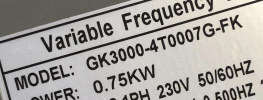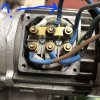UpdateI think ya'll might be missing the point the motor was originally wired to something other than VFD when the blue wire was used. Now, per the diagram in post #3 shows the motor is wired for a Wye (Star) connection with the blue wire connected. No idea how it was used originally.. For wiring to VFD the only wires needed are the 3 phases connecting to R, S, T and a ground wire connected to frame of motor.
Listen to JoeBusic, he seems very knowledgeable of wiring methods over there. Their methods are different than on this side (USA) of pond. Over here we tend to purchase VFD that take 1 ph 220 vac that uses 2 hot wires and a neutral. Over there they tend to use 1ph 220 vac that uses one hot wire and neutral. Of course ground wire for safety. The VFD is still going to put out 3 phases (wires) of voltage depending on voltage needed.
USA 3 ph motors tend to be dual voltage (230/460) that is wired in Wye (Star) mode. A motor has 6 coils giving 12 leads. Normally the T10, T11, & T12 leads are tied together inside the motor bringing 9 leads out putting the motor in the Wye wiring. I've seen a few 12 lead motors with no labels on the leads. That always requires sorting the polarity of the coils to wire up.
As Nathan said, lots of good knowledge in this thread, but also some errors so read with caution.
I plugged it in and The breaker immediately tripped so I don’t know what the problem is…. but maybe it’s a grounding issue but of course I don’t know what to do….
R S are the 220 input.
U V W are the 3x380 output to the motor.
I appreciate all the responses and willingness to educate and help. But the language of electrical work is one I don’t speak well. Even less so than my weak French.
Last edited:





